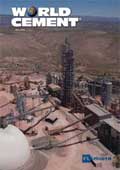Editorial comment
In his luncheon address to delegates at last year’s IEEE-IAS/PCA Conference in Miami, Titan America’s CEO, Aris Papadopoulos, stated that sustainable development was not only the construction industry’s greatest challenge, it was also its greatest opportunity.
Register for free »
Get started now for absolutely FREE, no credit card required.
In his luncheon address to delegates at last year’s IEEE-IAS/PCA Conference in Miami, Titan America’s CEO, Aris Papadopoulos, stated that sustainable development was not only the construction industry’s greatest challenge, it was also its greatest opportunity. He called upon multiple industry associations to work more closely together, and to lead the industry to continuously improve the environmental footprint of concrete structures. In his other roles as Vice Chairman of the Portland Cement Association, and Chairman of the Sustainable Development Committee, he will be well pleased that his words were heeded last month, when North America’s concrete associations, namely the PCA, National Ready Mixed Concrete Association, National Concrete Masonry Association and Precast/Prestressed Concrete Institute signed a memorandum of understanding to align sustainable development activities. As a group, the organisations will concentrate on the sustainable development applications of all concrete structures. The memorandum outlines eight specific social values that these structures provide: resource efficiency, safety/protection, financial responsibility, operational continuity, longevity/durability, byproducts reduction, aesthetics and societal connectivity. Papadopoulos sees this as, “a chance to bring together our diverse resources to focus on building sustainable housing, roads, schools and other structures”. Cross to the other side of the world where, three days later, Bjorn Stigson, President of the World Business Council for Sustainable Development, speaking in Paris, issued a stark warning: “Unless there is immediate action, thousands of new buildings will be built without any concern for energy efficiency, and millions of existing, inefficient buildings using more energy than necessary will still be standing in 2050. Acting now means reducing energy consumption and making real progress in controlling climate change”. He was speaking at the launch of the report from the WBCSD’s four-year, US$15 million Energy Efficiency in Buildings (EEB) research project, said to be the most rigorous study ever conducted on the subject. Taking as its title, ‘Transforming the Market: Energy Efficiency in Buildings’, the report provides new modelling by the WBCSD to show how energy use can be cut by 60% by 2050. EEB’s research covered the residential and commercial building sectors in the US, EU, Japan, China, India and Brazil. Together, these countries/ regions consume about two-thirds of current global energy output. All good stuff, you will say, but what about building owners and occupants? It seems, claims Stigson,“most of them don’t know enough and don’t care enough about energy consumption, and inertia is reinforced by assumptions that costs are too high and savings too low”.
Can such a report, or the concrete organisations and construction industry associations provide the necessary stimulus to change attitudes? Cynics will probably deride such moves, claiming “it’s all been said before", or, "where’s the proof?” To which we reply, take a close look at New York’s most iconic structure, the Empire State Building. It was built in the middle of the Great Depression in 1931, and was for over 40 years, the world’s tallest building. It is currently undergoing a US$20 million energy efficiency retrofit. Greenhouse emissions will be reduced by about 40% with annual energy savings calculated to be about US$.4 million per year. Just one example of what can and – according to the world’s leading authorities – must be achieved.


